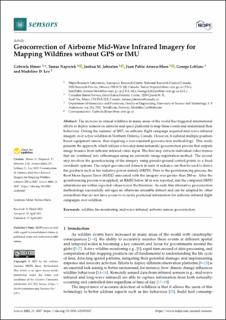| dc.description.abstract | The increase in annual wildfires in many areas of the world has triggered international efforts to deploy sensors on airborne and space platforms to map these events and understand their behaviour. During the summer of 2017, an airborne flight campaign acquired mid-wave infrared imagery over active wildfires in Northern Ontario, Canada. However, it suffered multiple position-based equipment issues, thus requiring a non-standard geocorrection methodology. This study presents the approach, which utilizes a two-step semi-automatic geocorrection process that outputs image mosaics from airborne infrared video input. The first step extracts individual video frames that are combined into orthoimages using an automatic image registration method. The second step involves the georeferencing of the imagery using pseudo-ground control points to a fixed coordinate systems. The output geocorrected datasets in units of radiance can then be used to derive fire products such as fire radiative power density (FRPD). Prior to the georeferencing process, the Root Mean Square Error (RMSE) associated with the imagery was greater than 200 m. After the georeferencing process was applied, an RMSE below 30 m was reported, and the computed FRPD estimations are within expected values across the literature. As such, this alternative geocorrection methodology successfully salvages an otherwise unusable dataset and can be adapted by other researchers that do not have access to accurate positional information for airborne infrared flight campaigns over wildfires. | en_US |

